
Jiangxi is an inland province in the east of the People's Republic of China. Its major cities include Nanchang and Jiujiang. Spanning from the banks of the Yangtze river in the north into hillier areas in the south and east, it shares a border with Anhui to the north, Zhejiang to the northeast, Fujian to the east, Guangdong to the south, Hunan to the west, and Hubei to the northwest.

Nanchang is the capital of Jiangxi Province, China. Located in the north-central part of the province and in the hinterland of Poyang Lake Plain, it is bounded on the west by the Jiuling Mountains, and on the east by Poyang Lake. Because of its strategic location connecting the prosperous East and South China, it has become a major railway hub in Southern China in recent decades.

Jiujiang, formerly transliterated Kiukiang and Kew-Keang, is a prefecture-level city located on the southern shores of the Yangtze River in northwest Jiangxi Province in the People's Republic of China. It is the second-largest prefecture-level city in Jiangxi and its borders include Poyang Lake, the largest freshwater lake in China. Jiujiang is the fourth largest port on the Yangtze River and was one of the first five cities that were opened to foreign trade along the Yangtze River following the implementation of Deng Xiaoping's Opening-Up Policy. It is Jiangxi's only international trade port city.

Fengcheng is a county-level city in northern Jiangxi province, People's Republic of China, under the administration of Yichun, located along China National Highway 105 and on the eastern (right) bank of the Gan River about 55 kilometres (34 mi) south of Nanchang, the provincial capital. The literal translation of the name is "Abundance City", due to its importance as a major commercial hub for agricultural products. There are 26 towns and 7 sub-districts comprising a total area of 2,845 square kilometres (1,098 sq mi) and its population is around 1,370,000. The 2005 GDP was more than 9.1 billion RMB.

Jiangxia District is one of 13 urban districts of the prefecture-level city of Wuhan, the capital of Hubei province, China, situated on the eastern (right) bank of the Yangtze River. Jiangxia district has an area of 2,009 square kilometres (776 sq mi) and a population of 680,000. It is the southernmost and most sparsely populated of Wuhan's districts. It borders the districts of Caidian and Hannan across the Yangtze and Hongshan to the north, as well as the prefecture-level cities of Ezhou to the east, Huangshi to the southeast, and Xianning to the south.

Qiemo County as the official romanized name, also transliterated from Uyghur as Qarqan County, is a county under the administration of the Bayin'gholin Mongol Autonomous Prefecture in the Xinjiang Uyghur Autonomous Region of the People's Republic of China, bordering the Tibet Autonomous Region to the south. Its area is 138,645 square kilometers (53,531 sq mi) and, according to the 2002 census, it has a population of 60,000. The county seat is at Qiemo Town.
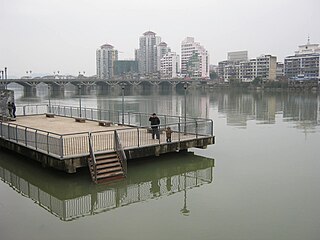
Shaowu is a county-level city in northwestern Fujian province, People's Republic of China, located in the central part of the Wuyi Mountains and bordering Jiangxi province to the west. It has more than 100,000 inhabitants. The local dialect combines elements from Northern Min and Gan Chinese.

Nanchang Changbei International Airport is an international airport serving Nanchang, the capital of East China’s Jiangxi province. It is located 28 km (17 mi) north of Nanchang. Construction began in October 1996 and the airport went into operation on 10 September 1999, replacing Nanchang Xiangtang Airport. It was upgraded to an international airport and was greatly expanded in 2008–2011.
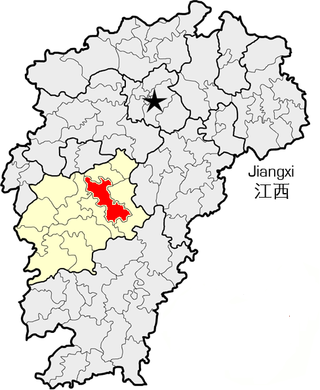
Jishui is a county located on the Gan River in Ji'an city, Jiangxi province, China.

Yongxiu is a county under the administration of Jiujiang City in northern Jiangxi province, People's Republic of China, on the western shores of Poyang Lake. As of 2005, the county has a total population of 361,000 residing in an area of 2,035 square kilometres (786 sq mi). Bordering counties are Duchang, Xingzi, De'an, Wuning, Jing'an, Xinjian, and Anyi, while the county seat is 40 kilometres (25 mi) north of Nanchang, the provincial capital, and 80 km (50 mi) south-southwest of downtown Jiujiang.

Luxi County is located in Honghe Hani and Yi Autonomous Prefecture, Yunnan province, China. Luxi was the capital of the medieval Yi Ziqi Kingdom.
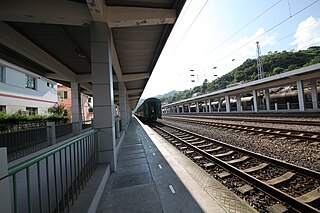
Ningqiang County is a county and both the southwesternmost and westernmost county-level division of Shaanxi province, China, bordering both Sichuan and Gansu. It is under the administration of Hanzhong City. The source of the Han River is located in the county.
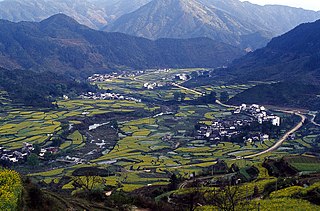
Wuyuan is a county in northeastern Jiangxi province, People's Republic of China, bordering the provinces of Zhejiang to the east and Anhui to the north. It is under the jurisdiction of the prefecture-level city of Shangrao.
Tianyang District is a district in western Guangxi, China. It is under the administration of the prefecture-level city of Baise.
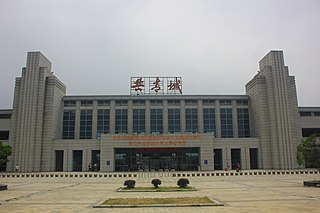
Gongqingcheng is a sub-prefecture-level city in Jiangxi, People's Republic of China. It was established on 10 September 2010 in the jurisdiction of Jiujiang. It is located 62 kilometres (39 mi) north of Nanchang, the provincial capital. On 1 July 2014, it was re-designated as being directly administered by the province, i.e. a sub-prefecture-level city. Situated in the vicinity of De'an, Yongxiu, and Lushan counties, it lies in the foothills of Mount Lu and lies on the western shore of Poyang Lake. With an area of 193 square kilometres (75 sq mi), it is home to 120,000 people, including 68,000 permanent residents. There are plans for the city to expand the population to 400,000 people. It is the only city in China to be named after the Communist Youth League of China, which in Chinese is abbreviated to "共青团"; hence its name literally means "Communist Youth League City".
Xiangtang may refer to the following locations in China:
Shangmei Town was a historic town and the former seat of Xinhua County in Hunan, China. The town was reformed through the amalgamation of Liaoyuan Township (燎原乡), Beidu Township (北渡乡), Fenglin Township (枫林乡) and Chengguan Town in 1995.

Xiangtang–Putian railway or Xiangpu railway, is a Class I higher-speed railway in eastern China linking Nanchang and Fúzhou (福州), the provincial capitals, respectively, of Jiangxi and Fujian Province. The line is named after Xiangtang, a township south of Nanchang, which was originally slated to serve as a terminus, and Putian, on the coast of Fujian, at which the southern branch of the Xiangpu railway terminates. The line actually begins at the Lehua East Station, a rail junction for the Beijing–Kowloon and Nanchang–Jiujiang intercity railways north of Nanchang. The line heads south to Nanchang West Railway Station and bypasses Xiangtang on its way to Fǔzhou (抚州). After entering Fujian, the line forks at Yongtai with the northern fork heading to Fúzhou (福州) and the southern fork going to Putian. The Nanchang to Yongtai section of the line plus the northern fork to Fuzhou is officially named the Nanchang–Fuzhou or Changfu railway. The southern fork is officially named the Yongtai–Putian or Yongpu railway.
Nanchang Qingyunpu Airport, also known as Sanjiadian Airport, is an airport in Qingyunpu District of Nanchang, Jiangxi, China. Originally constructed for use by the Republic of China Air Force, it was the largest airport in China when opened in 1935. The airport was destroyed during the Second Sino-Japanese War and rebuilt afterwards. After 1949, it was mainly used for test flights by the aircraft manufacturer Hongdu Aviation Industry Group, until its replacement by Nanchang Yaohu Airport in 2018.
Nanchang Xiangtang Airport is a People's Liberation Army Air Force Base in Xiangtang in East China's Jiangxi province. It served as the city's civilian airport from 1 January 1957 until 10 September 1999, when all commercial flights were transferred to the newly-built Nanchang Changbei International Airport.


















